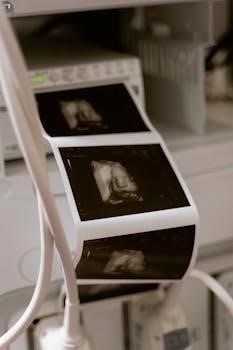Here’s the content for the “NASCAR Scanner Frequencies 2023⁚ An Overview” section, incorporating information from the provided internet snippets⁚
NASCAR Scanner Frequencies 2023⁚ An Overview
The 2023 NASCAR season offered fans the exciting opportunity to listen in on team communications using scanners.
Access to driver, team, and race control frequencies provided an unparalleled, behind-the-scenes experience at the track.
Understanding NASCAR Scanner Usage
Using a scanner at a NASCAR race enhances the experience, offering real-time insights into team strategies and driver communications. Fans can monitor driver-crew chief conversations, gaining a deeper understanding of in-race adjustments and decisions. Beyond team channels, scanners enable access to race control frequencies, allowing listeners to follow official directives and understand the reasoning behind penalties or cautions.
Media frequencies, such as those used by Motor Racing Network (MRN) and Performance Racing Network (PRN), provide an alternative broadcast perspective. However, understanding scanner usage requires knowing the available frequencies, which can change, and properly programming the scanner. Resources like online forums and scanner programming software can aid in this process. Being aware of analog versus digital frequency types is also crucial for clear reception.
At the track, strategic scanner use involves understanding optimal listening points and potential interference sources. A well-programmed scanner can significantly enrich the race-day experience.
Key Frequencies to Monitor in 2023
During the 2023 NASCAR season, monitoring driver frequencies allowed fans to hear team communications.
Race control frequencies provided insight into official decisions.
Media frequencies offered access to radio broadcasts like MRN and PRN.
Driver Frequencies
Driver frequencies are essential for fans who want to listen to the communication between the driver, crew chief, and spotter.
These frequencies are specific to each driver and car number.
For example, in 2023, Ross Chastain used 463.2375 MHz as his primary frequency, while Austin Cindric used 466.2125 MHz.
Austin Dillon’s primary frequency was 469.0125 MHz.
These frequencies allow listeners to hear real-time strategy discussions, car performance updates, and driver feedback.
Secondary frequencies are also used by some teams as backup channels, like Chastain’s 469.3875 MHz and Cindric’s 452.6750 MHz.
Keeping an updated list of these frequencies is crucial, as teams may change them.
Scanner frequencies follow the car, not the driver, so changes occur when drivers switch teams.
Some teams also use specific tones or squelch codes, which may vary from track to track.
Listening to driver frequencies offers an engaging perspective of the race.
Race Control Frequencies
Race control frequencies are critical for monitoring communications related to the overall management of the NASCAR event.
These frequencies are used by NASCAR officials to communicate instructions, safety updates, and penalties.
In 2023, key race control frequencies included 461.200 MHz with a 432 DPL code and 464.600 MHz with a 631 DPL code.
Monitoring these frequencies provides insight into decisions made during the race, such as caution periods, restart procedures, and rulings on track incidents.
Race control also coordinates with safety and fire personnel, with frequencies like 451.2250 MHz used for safety communications.
Staying informed about race control frequencies helps fans understand the context of the race and the actions taken by officials.
While driver frequencies offer a team-specific view, race control frequencies provide a broader perspective on the event’s dynamics and the enforcement of regulations.
These frequencies generally remain consistent across different tracks.
Media Frequencies (MRN, PRN)
Media frequencies are essential for fans who want to listen to live race broadcasts from Motor Racing Network (MRN) and Performance Racing Network (PRN).
These networks provide play-by-play commentary, interviews, and expert analysis throughout the NASCAR event.
In 2023, both MRN and PRN primarily used the frequency 454.0000 MHz for their broadcasts.
Additionally, PRN may have used secondary frequencies such as 450.8375 MHz and 455.8375 MHz, both with a 167.9 tone.
These frequencies allow fans at the track to follow the race even when they can’t see the entire track.
Listening to MRN and PRN provides a comprehensive understanding of the race.
It offers insights into strategy, driver performance, and race updates.
These broadcasts add another layer to the experience.
They help enthusiasts stay engaged.
Media frequencies are crucial for a complete race day experience;
They complement the scanner experience by integrating professional commentary.

Finding Updated Frequency Lists
Finding current NASCAR scanner frequencies requires consulting reliable online resources.
These resources include racing forums, scanner enthusiast websites, and dedicated frequency databases which are regularly updated by fans and experts.
Online Resources and Forums
For updated NASCAR scanner frequencies, online resources and forums are invaluable. Websites dedicated to racing and scanner enthusiasts often compile and maintain frequency lists. These lists typically include frequencies for drivers, teams, race control, and media broadcasts like MRN and PRN. Forums provide a platform for fans to share updates, verify frequencies, and discuss changes they’ve observed at the track.
Reliable sources often include dedicated frequency databases and racing-specific websites. It’s important to cross-reference information from multiple sources to ensure accuracy, as frequencies can change due to various factors. User-submitted information on forums should be verified when possible.
Keep an eye out for frequency lists specifically updated for the 2023 season, as frequencies can vary from year to year. Checking these resources close to race day is a good practice to ensure you have the latest information for a specific event. Many fans share tips and tricks for using scanners at the track, enhancing the overall race experience.
Scanner Programming Software
Scanner programming software is essential for efficiently loading NASCAR frequencies into your scanner. Instead of manually entering each frequency, software allows you to import lists directly, saving time and reducing errors. Several software options cater to different scanner models, including Uniden and others.
These programs often allow you to organize frequencies by series (Cup, Xfinity, Trucks) or by team, making it easier to navigate during a race. Some software even includes features for managing tones and squelch codes, which are crucial for clear reception. Look for software that supports importing frequency lists in common file formats like Excel spreadsheets or text files.
Before purchasing any software, check for compatibility with your specific scanner model and operating system. Many vendors offer free demo versions, allowing you to test the software before committing to a purchase; Always download software from reputable sources to avoid malware or other security risks. Regularly updating your software ensures compatibility with the latest frequency changes.

Analog vs. Digital Frequencies
In the world of NASCAR scanner frequencies, understanding the difference between analog and digital is crucial for optimal listening. While some NASCAR frequencies remain analog, a growing number have transitioned to digital. Analog frequencies transmit audio using continuous radio waves, while digital frequencies convert audio into digital data packets.
To listen to digital frequencies, you’ll need a scanner capable of decoding digital signals. Analog scanners will only pick up static or garbled noise on digital channels. Digital scanners are generally more expensive than analog models, but they offer access to a wider range of communications.
Even in 2023, some key NASCAR frequencies, particularly those used by fans and some teams, remained analog, ensuring accessibility for those with older scanners; However, many critical communications, including race control and certain team channels, utilized digital formats for enhanced security and clarity. Check frequency lists carefully to determine whether a channel is analog or digital before programming your scanner.

Tips for Using a Scanner at the Track
Using a scanner at a NASCAR track can greatly enhance your race day experience. Before heading to the track, program your scanner with the most up-to-date frequency lists, including driver, team, and race control channels. Consider bringing a frequency sheet as a backup. Arrive early to avoid crowds and potential signal interference.
Bring extra batteries or a portable power bank to keep your scanner running throughout the race. Use headphones or earbuds to clearly hear the scanner audio amidst the noise of the track. Be aware of your surroundings and other fans while using your scanner.
Experiment with different squelch settings to minimize static and improve audio clarity. If you encounter interference, try adjusting your scanner’s antenna or moving to a different location. Remember that teams sometimes change frequencies.

Github Repository for Scanner Frequencies
A valuable resource for NASCAR scanner enthusiasts is the GitHub repository dedicated to maintaining and updating scanner frequencies. This repository serves as a collaborative platform where individuals can contribute and access the latest frequency information for various NASCAR series. The repository typically includes files that can be imported into popular scanner models like Uniden HomePatrol and Uniden BCT125.
Users can submit pull requests or tickets to suggest updates or corrections to the frequency lists. The repository often contains frequency data formatted for different scanner programming software, making it easier for users to load the information into their devices. It’s a community-driven effort to keep scanner enthusiasts informed and connected.
Common Frequency Changes and Updates
Staying up-to-date with NASCAR scanner frequencies is crucial, as changes and updates are common throughout the season. Teams may alter frequencies due to interference, local track conflicts, or strategic reasons, making real-time adjustments necessary; Driver changes, particularly in the Truck series, often lead to frequency modifications.
Scanner frequencies typically follow the car number rather than the driver, so changes are linked to vehicle assignments. To ensure accuracy, consulting updated frequency lists close to race day is recommended. Fans can find these updates through online resources, racing forums, and scanner programming software. Additionally, being aware of OTA programming options for scanners like the re3000 can provide access to immediate frequency updates at the track.


